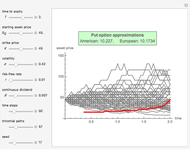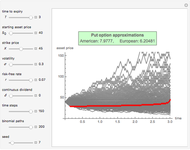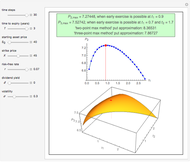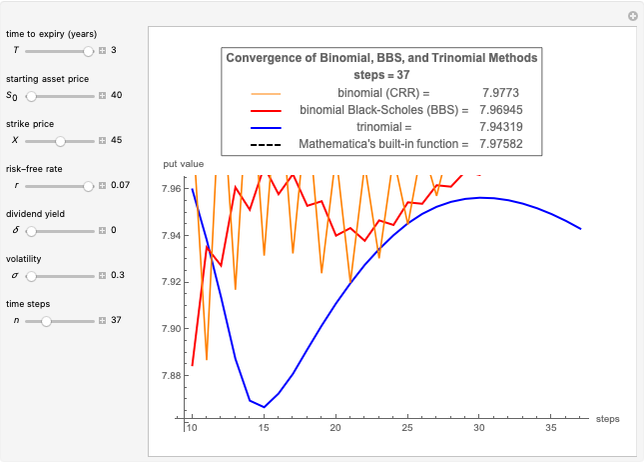Pricing Put Options with the Explicit Finite-Difference Method

Requires a Wolfram Notebook System
Interact on desktop, mobile and cloud with the free Wolfram Player or other Wolfram Language products.
This Demonstration shows a put option's value function versus the time to expiry and the asset's log price. The 3D plot shows the American (red dots) and the European (blue dots) put values at each grid point. The European put value is never greater than the American, because the American put can be exercised at any time up to maturity, while the European put can only be exercised at maturity. Use the controls to define the option parameters and the time discretization.
Contributed by: Michail Bozoudis (July 2014)
Suggested by: Michail Boutsikas
Open content licensed under CC BY-NC-SA
Snapshots
Details
The explicit finite-difference method [1] is applied to solve the Black–Scholes–Merton partial differential equation using a uniform log price and time grid. The asset log price discretization is calculated automatically in order to ensure stability and convergence. Compared to the implicit finite-difference method, the explicit finite-difference method is considered simpler and faster but less stable and accurate. It is relatively accurate for a small number of steps. The explicit finite-difference method is similar to the trinomial method, in that both provide an explicit formula for determining future states of the option process in terms of the current state, whereas the implicit finite-difference method requires the iterative solution of linear equations linking consecutive time steps [2].
References
[1] M. Brennan and E. Schwartz, "Finite Difference Methods and Jump Processes Arising in the Pricing of Contingent Claims: A Synthesis," The Journal of Financial and Quantitative Analysis, 13(3), 1978 pp. 461–474. www.jstor.org/stable/2330152.
[2] P. Boyle, "Option Valuation Using a Three-Jump Process," International Options Journal, 3, 1986 pp. 7–12.
Permanent Citation





























